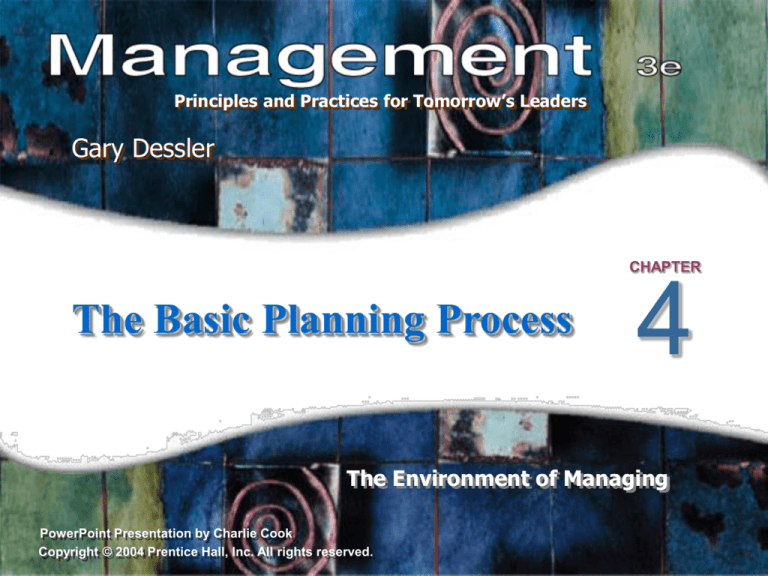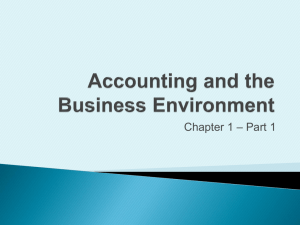
Principles and Practices for Tomorrow’s Leaders
Gary Dessler
CHAPTER
The Basic Planning Process
4
The Environment of Managing
PowerPoint Presentation by Charlie Cook
Copyright © 2004 Prentice Hall, Inc. All rights reserved.
Chapter Objectives
After studying this chapter and the case exercises at
the end, you should be able to:
1. Develop a usable plan for an organization.
2. Write an outline of the required business plan,
and provide specific examples of its
component functional plans.
3. Express the necessary plan in descriptive,
graphic, and financial formats.
4. Explain what the manager did right and did
wrong with respect to setting goals for
subordinates.
5. Explain the forecasting tools you think the
manager should use, and why.
Copyright © 2004 Prentice Hall. All rights reserved.
4–2
The Nature And Purpose Of Planning
• Plan
A method for doing or making something,
consisting of a goal and a course of action.
• Goal
A specific result to be achieved; the end result of a
plan.
• Objectives
Specific results toward which effort is directed.
Copyright © 2004 Prentice Hall. All rights reserved.
4–3
The Nature And Purpose Of Planning
(cont’d)
• Planning
The process of setting goals and courses of action,
developing rules and procedures, and forecasting
future outcomes.
• What Planning Entails
Choosing goals and courses of action and deciding
now what to do in the future to achieve those goals.
Assessing today the consequences of various future
courses of action.
Copyright © 2004 Prentice Hall. All rights reserved.
4–4
What Planning Accomplishes
• Allows decisions to be made ahead of time.
• Permits anticipation of consequences.
• Provides direction and a sense of purpose.
• Provides a unifying framework; avoiding
piecemeal decision making.
• Helps identify threats and opportunities and
reduces risks.
• Facilitates managerial control through the setting
of standards for monitoring and measuring
performance.
Copyright © 2004 Prentice Hall. All rights reserved.
4–5
The Management Planning Process
• Hierarchy of Plans
A set of plans that includes the company-wide plan
and the derivative plans of subsidiary units required to
help achieve the enterprise-wide plan.
Top management approves a long-term plan; and
each department creates its own budgets
• The Planning Hierarchy
Top management formulates its plans based on
upward feedback from the departments, and the
departments in turn draft plans that make sense in
terms of top management’s plan.
Copyright © 2004 Prentice Hall. All rights reserved.
4–6
Hierarchy of Goals
FIGURE 4–1
Copyright © 2004 Prentice Hall. All rights reserved.
4–7
Checklist 4.1
How to Develop a Plan
Set an objective.
Develop forecasts and planning
premises.
Determine your options.
Evaluate alternatives.
Choose your plan, and start to
implement it.
Go to Level 2.
Copyright © 2004 Prentice Hall. All rights reserved.
4–8
Who Does the Planning?
• Small businesses:
Entrepreneurs do most of the planning.
• Large firms:
Traditional:
A central
corporate planning group works with top
management and each division to solicit, challenge, and
refine the company’s plan.
Current:
Planning
is decentralized and includes the firms’
product and divisional managers, aided by small
headquarters advisory groups.
Copyright © 2004 Prentice Hall. All rights reserved.
4–9
The Business Plan And Its Components
• Description of the business (including ownership
and products or services)
• Marketing plan
• Financial plan
• Management and/or personnel plan.
Copyright © 2004 Prentice Hall. All rights reserved.
4–10
Outline
of a
Marketing
Plan
FIGURE 4–3
Source: Source: Adapted
from Philip Kotler and Gary
Armstrong, Principles of
Marketing (Upper Saddle
River, NJ: Prentice Hall,
2001), p. 70.
Copyright © 2004 Prentice Hall. All rights reserved.
4–11
Acme’s Potential Market Segments
Source: Business Plan Pro, Palo Alto Software, Palo Alto, CA.
Copyright © 2004 Prentice Hall. All rights reserved.
FIGURE 4–4
4–12
Product,
Pricing,
and Sales’
Forecasts
Source: Business Plan Pro, Palo Alto Software, Palo Alto, CA.
Copyright © 2004 Prentice Hall. All rights reserved.
FIGURE 4–5
4–13
Personnel Plan
Source: Business Plan Pro, Palo Alto Software, Palo Alto, CA.
Copyright © 2004 Prentice Hall. All rights reserved.
FIGURE 4–6
4–14
Sales Forecast by Service:
Two-Month Sales Plan for Acme Consulting, 2003
FIGURE 4–7
Copyright © 2004 Prentice Hall. All rights reserved.
4–15
Gantt Scheduling Chart for
Acme Strategic Report Projects, January 1–15, 2003
FIGURE 4–8
Copyright © 2004 Prentice Hall. All rights reserved.
4–16
Acme
Consulting
Profit and
Loss
FIGURE 4–9
Source: Business Plan Pro, Palo Alto
Software, Palo Alto, CA.
Copyright © 2004 Prentice Hall. All rights reserved.
4–17
Copyright © 2004 Prentice Hall. All rights reserved.
4–18
Copyright © 2004 Prentice Hall. All rights reserved.
4–19
Reporting
Improper
Behavior
FIGURE 4–10
Source: James Jenks, The
Hiring, Firing (and everything
in between) Personnel Forms
Book (Ridgefield, CT: Round
Lake Publishing, 1996), pp.
224–25.
Copyright © 2004 Prentice Hall. All rights reserved.
4–20
Copyright © 2004 Prentice Hall. All rights reserved.
4–21
Checklist 4.2 Principles of Goal-Setting
Set SMART goals—make them specific,
measurable, attainable, relevant, and timely.
Choose areas (sales revenue, costs, and so
forth) that are relevant and complete.
Assign specific goals.
Assign measurable goals.
Assign doable but challenging goals.
Encourage participation.
Use executive assignment action plans, or
management by objectives.
Copyright © 2004 Prentice Hall. All rights reserved.
4–22
Copyright © 2004 Prentice Hall. All rights reserved.
4–23








